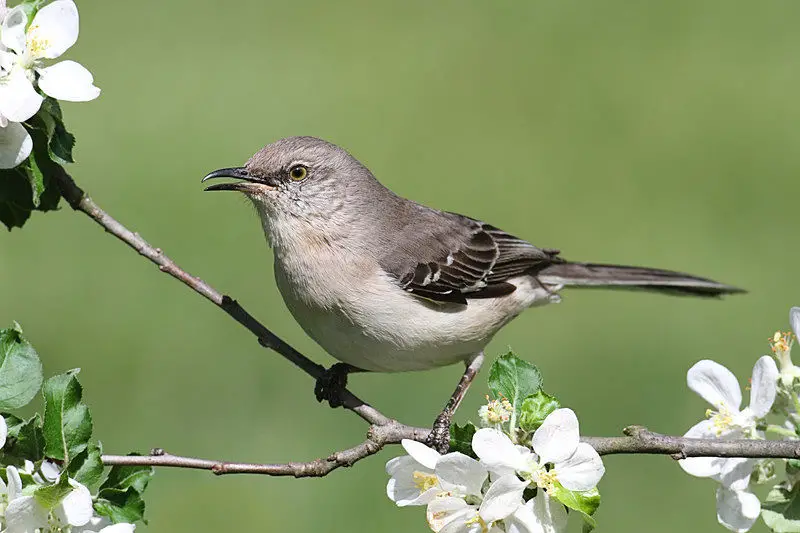
Mimus polyglottos: “many-tongued mimic.” That’s the exceptionally apt Latin name for the Northern Mockingbird, a celebrity among American songbirds (emphasis on the “song”). From the well-known “Hush Little Baby” lullaby to the title of Harper Lee’s classic civil-rights-era novel (To Kill a Mockingbird, of course) – and perhaps also due to the legacy of a brisk, bygone pet trade – the mockingbird carries significant cultural cachet even outside its mostly southerly distribution.
Within that distribution, Northern Mockingbirds aren’t regular visitors to birdfeeders, but they are common sights around the yard and around parks, foraging flashily (literally) in the grass. And with their versatile voices, they definitely add a distinctive (and, given their Mimus-style mimicry, sneaky) melody – or shall we say melodies – to the local avian soundtrack.
Appearance and identification
Northern Mockingbirds share the same basic form as the thrashers with which they and the other mockingbirds rub shoulders in the family Mimidae. They’re more slender and short-billed than your typical thrasher, however. Their fairly drab body color scheme – pale gray above, whitish below – is compensated for by blackish wings and tails boldly marked with white. The white patch of both the upper and lower wings are diagnostic features easily seen not only in flight, but during the frequent spreading of wings that characterizes the mockingbird’s on-the-ground foraging. Both males and females boast a sooty “lore” between the eye and the base of the bill.
Juvenile “mockers,” meanwhile, resemble adults but have a speckled breast.
The Northern Mockingbird is on the smaller side for a mimid, roughly nine or 10 inches long with a wingspan of a bit more than a foot. Potential lookalikes of the Northern Mockingbird include the Sage Thrasher (with a streaked belly and no big white wing patches), the Northern and Loggerhead shrikes (proportionately much bigger-headed, with a larger eye mask and a wickedly hooked bill), and perhaps another mimid relative, the Gray Catbird (but clearly distinct with a uniformly gray body and a distinctive black cap). More problematic, if only in a tiny corner of the country, would be a Bahama Mockingbird, a slightly larger and duller tropical relative of the Northern Mockingbird that occasionally strays into South Florida.
Location and habitat
Northern Mockingbirds are most widely distributed in the central and southern USA; as Kenn Kaufman writes in his Birds of North America, the “Northern” in the species name reflects not the species’s specific North American geography but the fact that other mockingbirds are mainly found from the Mexico and the Caribbean south.
The heart of Northern Mockingbird range extends from California across the Southwest into the lower American Midwest, South, and most of the East. Mockingbirds have expanded significantly in New England – perhaps, as Audubon suggests, at least partly because of the spread (both as cultivated and feral, invasive plant) of Multiflora Rose, favored by the bird for its rosehips as well as its nesting potential.
Northern Mockingbirds are resident across much of their range, though in the northern fringe some birds may head south for the winter; needless to say, mockingbird migration – such as it is – isn’t clearly understood.
These birds favor fairly open landscapes, including farmland, suburbs, greenspaces, brushfields, and shrubby woodlands. In the more arid Southwest reaches of the country, mockingbirds commonly haunt riparian thickets.
What do Northern Mockingbirds eat?
Northern Mockingbirds are omnivorous, their diet roughly split between arthropods (insects, spiders, etc.) – mostly a summer food – and berries, heavily eaten in winter.
Mockers often seek out invertebrate prey on the ground, stalking and dashing about and (as mentioned above) flaring their wings at regular intervals. They’ll also forage in trees and shrubs for both fruits and animal prey. Mockingbirds have also been observed lapping up sap leaking from cuts and other wounds on trees.
Communication and call song
Good luck neatly summarizing the song of the Northern Mockingbird: Males in particular may commit to memory on the order of 200 songs in the ever-expanding repertoire of their lifetime. Mockingbirds typically repeat short musical phrases, then switch to different series; these often incorporate convincing mimicries of the songs of other birds. (They’re not called mockingbirds for no reason.)
Both male and female mockingbirds sing, but females do so more softly and typically mainly in the fall, perhaps when they’re staking out winter digs. Male mockingbirds usually sing from late winter through midsummer and then again in the autumn; their sonic “program” for each of those seasonal stretches may be different.
A male singing to define his territory often flaps up into the air a short ways during the song. Particularly when the moon is bright, mockingbirds may keep up their warbling overnight – unusual for a songbird.
Mockingbird calls tend to be short and harsh, meanwhile.
Nesting and mating/eggs and young
Males stake out nesting territories early–often by late winter in the South. They’ll perform their singing and wing-flapping displays, which–if the interest of a female is suitably piqued–may lead to male and female chasing each other around the staked-out zone. Mockingbirds are quite territorial and aggressive: Females will confront other females, males other males, and birds of other species–not to mention dogs, cats, even people–may be harassed in defense of the nesting site.
The male mockingbird typically builds the foundation of the cup-shaped nest out of twigs; the female lines it with grasses, leaves, animal fur, and other soft matter. The nest is typically constructed within a few dozen feet of the ground in a shrub or tree.
Females lay two to six eggs, often in two to three broods per season; these are incubated for 12 or 13 days, and then the hatchlings spend about that interval before fledging.
Sources
- Cornell Lab of Ornithology: All About Birds: Northern Mockingbird.
- Kaufman, Ken. 2000. Birds of North America. Houghton Mifflin Company.
- National Audubon Society. Guide to North American Birds: Northern Mockingbird.
- Sibley, David Allen. 2000. The Sibley Guide to Birds. Alfred A. Knopf.
